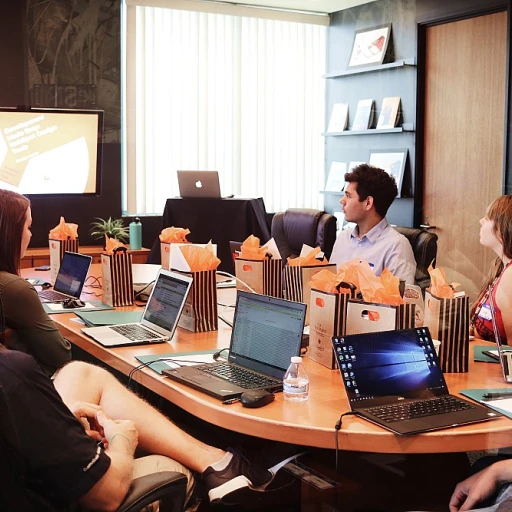The Rise of Interactive Technologies in the Workplace
Embracing Transformative Tools
The rise of interactive technologies in the workplace marks a significant shift towards a more dynamic and engaging work environment. These innovative tools are rapidly becoming integral to modern office setups, enhancing both productivity and efficiency. An essential component in this transformation is the implementation of advanced lighting solutions and other related systems.
Technologies such as cueserver and dmx control systems are bridging traditional barriers, allowing for seamless control of lighting fixtures and accessories. With the power to manage various systems—from architectural controls to systems wireless—companies are reimagining their workspaces to be more adaptable and responsive.
Brands that focus on interactive technologies often incorporate intelligent lighting systems, including LEDs and vari lite lamps, managed through ethernet cables and connectors. Additionally, fixture accessories and truss stands play a crucial role in accommodating these new interactive setups.
Organizations are also experimenting with wireless item control, enhancing flexibility and reducing clutter with cables and bags. Moreover, the integration of lighting fixture accessories and technologies interactive varieties reflects a broader move towards involving faculty staff in a more collaborative and inclusive decision-making process.
As these systems continue to evolve, so does the need for professionals to remain adept at navigating them. This demand for adaptation not only involves the development of technical skills but also entails understanding how to better leverage all interactive technologies available. The intersection of traditional methods with these emerging tools spearheads a new era for workplace innovation, setting the stage for further discussions on the challenges and considerations that lie ahead.
Redefining Collaboration and Communication
Transforming Team Dynamics
In the modern workplace, interactive technologies are revolutionizing how professionals collaborate and communicate, bridging gaps and enhancing productivity. As companies increasingly adopt wireless systems and interactive technologies, they streamline operations by enabling seamless interactions among team members. Lighting controls, such as the CueServer and DMX systems, are no longer limited to theatrical productions. These controls are now being integrated into workspaces to facilitate dynamic and adaptable lighting environments that improve focus and creativity. Interactive technologies like architectural controls and cueserver pro systems play a crucial role in redefining collaboration. By utilizing advanced technologies that offer efficient management of lighting fixtures, vari lite systems, and fixture accessories, businesses can craft spaces conducive to effective team collaborations. Systems wireless integrations ensure that communication flows effortlessly, regardless of where team members are situated, further enhancing the collaborative spirit.Powering Communication Channels
Communication within teams has become more efficient with the help of technological advancements like ethernet connectors and wireless technologies. These innovations diminish barriers, facilitating real-time exchanges and ensuring that ideas and solutions reach each team member with precision and speed. Companies investing in developing a robust technology framework, including cue server core and other advanced tools, reap the benefits of enhanced engagement and smoother workflows. To further understand how educational technology is playing into these dynamics, visit this insightful article on harnessing educational technology, which explores similar themes in learning environments.Incorporating Smart Technologies
The integration of smart technologies, such as interactive gels and LED systems, within organizational frameworks is significant in transforming communication avenues. Not only do they serve as powerful tools for enhancing visual communication, but they also improve the ambiance of workspaces, ensuring that team members can work in environments that are customized to their needs. As these transformations continue to evolve, companies must consider an adaptable approach towards communication and collaboration, taking into account the continuous development of innovative products and accessories led by industry leaders. This way, they can harness the full potential of available technologies to amplify their collaborative practices while being prepared for future advancements.Skill Development and Training Innovations
Enhancing Skill Development Through Interactive Learning
In an age where technology is rapidly evolving, staying up-to-date with the latest innovations is crucial for both individuals and organizations. Interactive technologies are transforming the landscape of skill development and training, offering a dynamic and engaging approach to learning.
The power of interactive technologies lies in its ability to provide an immersive learning environment. For instance, the integration of tools such as cueserver and cueserver core in training programs allows individuals to gain hands-on experience in real-time scenarios. These interactive systems facilitate a deeper understanding of complex topics, making learning both enjoyable and effective.
Moreover, lighting technologies such as LED and vari lite play a significant role in creating more engaging training spaces. The use of DMX lighting controls, along with lighting fixtures and fixture accessories, can help set the right mood and enhance concentration and retention.
Additionally, adopting systems wireless technologies and ethernet connectivity ensures a seamless delivery of content. As trainers harness the capabilities of wireless systems and integrated networks, they can offer more personalized and adaptive training experiences.
One cannot overlook the importance of architectural controls, which enable flexible reconfiguration of training spaces. The utilization of truss stands, lighting control accessories like lee filters, and lighting control systems ensures the environment is conducive to various learning styles.
In summary, the intersection of interactive technologies with traditional training methods is crafting a more effective and enriching learning journey. For those looking to dive deeper into how these technologies redefine workplace learning, we invite you to check out an insightful resource on envisioning the intelligent workplace of tomorrow.
Challenges and Considerations
Overcoming Hurdles in Implementing Interactive Solutions
The integration of interactive technologies into workplaces isn't devoid of challenges. Companies face several obstacles as they strive to adapt to innovative systems, powered by cutting-edge developments in lighting control, DMX technology, and ethernet connectivity.
- Technological Complexity: Interactive systems often comprise a plethora of components like truss stands, fixture accessories, and lighting fixtures. Experimental setups involving technologies like cueserver core and cueserver pro require comprehensive understanding, which can be a hurdle for some organizations.
- Cost Considerations: Initial investments in items such as architectural controls, wireless systems, and LED accessories can be substantial. Organizations must also factor in expenses for cables, connectors, and maintenance, impacting their budgetary allocations.
- Resource Allocation: Organizations need trained personnel to manage equipment from various brands interactive in nature. Faculty staff dedicated to operating and troubleshooting these advanced technologies are essential, yet not always readily available.
- Maintenance and Scalability: The upkeep of complex lighting and control systems—relying on cueserver flex and cueserver pro—requires consistent attention. Additionally, ensuring these solutions scale effectively with evolving company needs presents a continuous challenge.
Balancing Human Touch with Technological Advancements
The pivotal aim is to enhance productivity and collaboration. Yet, it’s essential to address how these shifts affect human interactions within the workspace. Cueserver-controlled environments might offer precision in control and power efficiency, but cannot overlook how automating processes may affect employees' engagement and satisfaction.
Ultimately, organizations grappling with the integration of these interactive systems must remain adaptive and focused on the overarching benefits while paying attention to minute details. The driving force should be creating environments where technological efficiency seamlessly enhances traditional human interactions.
Impact on Work-Life Balance
The Balancing Act of Work and Life
Interactive technologies are reshaping the traditional boundaries between work and life, offering both opportunities and challenges in maintaining a harmonious balance. As employees increasingly rely on systems and devices like cue servers, wireless technologies, and various lighting controls for their work, the lines between professional and personal time may blur.
The flexibility enabled by innovations in architecture controls and interactive systems can lead to more adaptable work schedules. This is beneficial for employees who might need balance between professional commitments and personal responsibilities. However, the constant connectivity offered by ethernet networks and wireless systems can also lead to longer working hours and increased pressure to be 'always on,' challenging the work-life balance that companies strive to support.
Moreover, ergonomic considerations must be taken into account. The rise in home offices propelled by technologies interactive and lighting fixtures such as LEDs and vari-lite systems enhances productivity but can impact personal spaces. Institutions aiming to improve work-life integration should consider investing in ergonomic products like adjustable lighting fixtures, truss stands, and suitable controls, that minimize the intrusion of work into personal life.
Faculty staff and employers are tasked with proactively designing guidelines that ensure work does not overshadow personal time. Implementing technologies in a way that respects personal boundaries is critical, like using dmx controls to schedule lighting cues that mark the start and end of working hours. This can create a visual reminder and help employees feel more disconnected from work after hours.
As companies explore brands interactive and develop new approaches for their workforce, such as item development and fixture accessories, it remains crucial to prioritize sustainable work practices that can foster a balanced life for employees. Considering options like lee filters and cue server flex, employers can ensure optimal working environments conducive to better productivity and mental health without compromising the critical balance of work-life harmony.
Future Trends and Predictions
Envisioning the Transformative Path Ahead
As we look toward the future, the trajectory of interactive technologies in the workplace reveals promising trends that will redefine how we work and interact. The landscape is rapidly evolving with technology advancements powering these changes, and key players in the industry like lighting control systems and cueserver technologies are at the forefront.
The interplay of LED lighting fixtures and architectural controls with state-of-the-art cue servers empowers organizations to create environments that enhance productivity and engagement. Wireless systems are increasingly becoming integral to workplace setups, allowing flexibility and adaptation to various tasks. The marriage of power and portability offered by modern technologies, including wireless systems and advanced control platforms, suggests a future where physical limitations are minimized.
The capability to navigate and manipulate these systems via Ethernet connections and DMX control further equips organizations to tailor their workspace dynamics. This convergence of systems not only optimizes workplace functionality but also streamlines the user experience, ensuring that faculty staff can efficiently manage their environments. Furthermore, the integration of fixture accessories, lighting fixtures, and brands such as Vari Lite demonstrates the industry’s commitment to fostering sustainable and innovative development.
With these technologies, the future of work is envisioned as a synergy of interactive elements that enhance collaboration, boost productivity, and support work-life balance. The ongoing development of control solutions, from cue server core to pro and flex versions, offers multiple capabilities and customizations extending the scope of interactive technologies. This evolution will likely influence not only the physical workspace but also the broader organizational culture.
To fully leverage these transformative technologies, organizations must consider the complexity of integrating multiple systems, from truss stands to LEDs, and the essential accessories required for optimal performance. Concepts like systems wireless, cue server pro, and DMX control are pivotal in redefining workplace dynamics. As industries explore these trends, they're also tasked with addressing potential challenges such as compatibility and infrastructure requirements, from lighting fixture setups to the intricacies of cables connectors and Ethernet networks.
In summary, the future of work is guided by an interactive ethos, with lighting cueserver systems and various innovations shaping a path that promises enhanced experiences for workers and organizations alike. As we navigate this evolving journey, the potential for groundbreaking shifts in work practices remains boundless, underscoring the importance of staying informed and adaptable.







